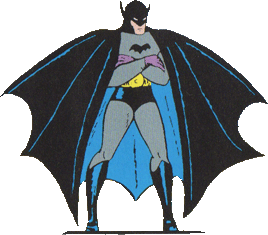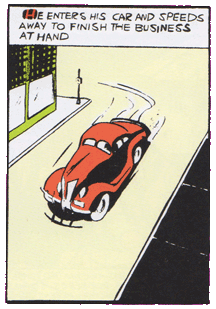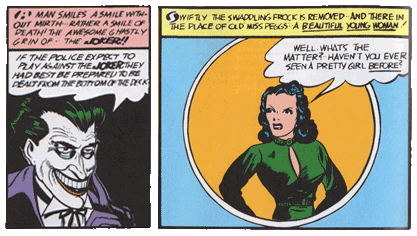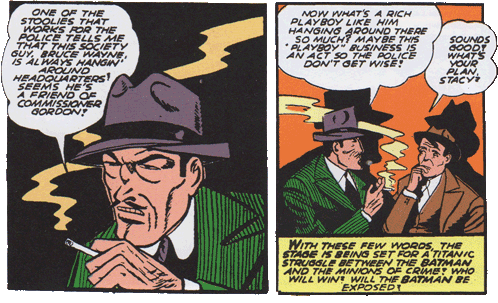

| December 2015 |
|
| Bill Finger and Bob Kane: Batman | |
 With some difficulty, I picked up Batman:The Golden Age Omnibus Volume 1. “With difficulty” because it's large format and weighs nearly five pounds. It's also $43.50, so I picked it up at the library.
With some difficulty, I picked up Batman:The Golden Age Omnibus Volume 1. “With difficulty” because it's large format and weighs nearly five pounds. It's also $43.50, so I picked it up at the library.
It reprints all the Batman from his origin in May 1939 (his very first appearance is shown at left), through November 1941… over 800 pages. Presumably Volume 2 will carry on, but it's not out yet.
All the Batman movies and video games are boldly labeled BATMAN CREATED BY BOB KANE, because Kane a) had the business sense to require it in his contract, and b) didn't extend the courtesy to his partner. So let's give credit where it's due: these first two and a half years of Batman were written by Bill Finger, and drawn by Kane. The magic of comic books is that they are normally drawn by one person and inked by another, the inkers here were usually Jerry Robinson and George Roussos.
It's fascinating to see the development of the comic and the slow buildup of Batman's mystique and his menagerie of enemies, and even minor details like the evolution of his logo. There are a large number of throwaway villains (most of them soundly killed off at the end of the story), but we pass one milestone after another. (The number is the page number in the Omnibus, which gives you a good idea of the progress through the œuvre.)
| Commissioner Gordon | 1 | Detective Comics #27, May 39 |
| Batplane and 'Baterang' | 50 | Detective Comics #31, Sep 39 |
| Origin story | 70 | Detective Comics #33, Nov 39 |
| Hugo Strange | 108 | Detective Comics #36, Feb 40 |
| Robin | 132 | Detective Comics #38, Apr 40 |
| The Joker | 148 | Batman #1, Spring 40 |
| Catwoman | 183 | Batman #1, Spring 40 |
| Clayface | 215 | Detective Comics #40, Jun 40 |
| Scarecrow | 757 | World’s Finest Comics #3, Fall 41 |
(DC trivia: “DC” comes from Detective Comics. Superman beat Batman to the drugstore racks by less than a year— he debuted in June 1938.
 Perhaps the one surprise from the list is the absence of Alfred, who wasn't introduced till 1943. I also didn't expect Robin quite so early. I'd always figured he was slipped in for kids to identify with— a dumb strategy, what kid wants to be Robin and not Batman?— but according to Wikipedia, the writers actually put him in so Batman would have someone to talk to.
Perhaps the one surprise from the list is the absence of Alfred, who wasn't introduced till 1943. I also didn't expect Robin quite so early. I'd always figured he was slipped in for kids to identify with— a dumb strategy, what kid wants to be Robin and not Batman?— but according to Wikipedia, the writers actually put him in so Batman would have someone to talk to.
One element that took time to develop was the Batmobile. At right you can see the Bat's first wheels, in pumpkin orange. A proper Batmobile with bat motifs doesn't appear for two years.
Many comics evolve spectacularly in their first few years before they take their classic form. But Batman is recognizably Batman from the first issue: careless playboy Bruce Wayne by day, grim avenging gadgeteer by night. By the third issue he's taking on supervillains— the first is “Doctor Death”. It's a bit surprising when Batman machine-guns some gangsters (in Batman #1, Spring 1940), but it's nearly a unique occasion… though it has to be said that in the early issues Batman doesn't take a lot of care to keep his enemies alive during a fight. E.g. he's happy to punch a man into a vat of acid, and Robin knocks a gangster off a girder on top of a high building.
Rather more surprising is that Batman has a fiancée— Julie, an actress. She's featured in a couple of early stories, then is seemingly forgotten for a couple of years. She comes back in March 1941, only to dump Bruce Wayne because he won't get a job. (Apparently Wayne Enterprises wasn't yet a thing.)
 The Joker is almost as old as Batman, and like him emerges nearly fully-formed: white thin face, green hair, purple suit, Joker toxin. The creators must have sensed they were on to something, since he's one of the relatively few early villains who wasn't killed off at the end. What he's missing is a personality: he's a psychopath, but so were the other weird villains of the day, and he isn't remotely funny.
The Joker is almost as old as Batman, and like him emerges nearly fully-formed: white thin face, green hair, purple suit, Joker toxin. The creators must have sensed they were on to something, since he's one of the relatively few early villains who wasn't killed off at the end. What he's missing is a personality: he's a psychopath, but so were the other weird villains of the day, and he isn't remotely funny.
Catwoman, by contrast, is already the thief and beautiful femme fatale she is today. She has no costume at first, though she does have an elaborate disguise as an old lady. (This is nothing unusual in these comics: it's almost routine for a little wax and makeup to change someone's appearance dramatically, and no one suspects. I don't think wax was that great at point blank range.) What's more unusual is that Batman lets her escape and even muses about her “lovely eyes”, much to the disgust of Robin. (Side note: some of the covers mention Batman's colleague Slam Bradley, who I remember from the Catwoman comics.)
Another curious fact: Catwoman isn't the only one with a penchant for jewels. Doctor Death and the Joker stole jewels too, as did common gangsters. You could probably do a dissertation on this… why did readers care about the expensive baubles of the super-rich? It's a weird narrative trope, though I guess less weird than the modern comics' notion that all the supervillains want to turn Gotham City into a smoking ruin.
Speaking of Gotham City, unless I missed something, Batman's city is not called that till Winter 1941. Back in 1940, Batman and Robin attended the New York World's Fair, and it's clear that this is a local visit— so at that point, he was a New Yorker. Gotham is not, at this point, particularly gothic— it has no distinctive architecture, and for that matter isn't terrorized by crime; even the Joker normally contents himself at this point with offing two or three people in an issue.
At one point a gangster correctly guesses Batman's identity (below). It's always been a poser why more people didn't make the connection. Guy with a high-tech suit and and endless supply of gadgets and vehicles… it doesn't seem like a big leap, and add to that the fact that you can see half his face. Oh, and Batman has a way of showing up in the same time and place as Bruce Wayne… e.g. when Wayne is on vacation miles from Gotham.
 I've gone this far without addressing the basic question: is it any good? Well, not really. Comics art and writing have actually improved immensely in 75 years. Kane's art and Finger's writing are only adequate. There's zero interest in actual crime, or rich people, or jewels, and this in a time when noir writers like Hammett and Chandler made the written detective story into classic literature, diving deep into the corruptions of American life. As adventure stories, they fall far short of their contemporaries, the lurid parables of Will Eisner or the exotic, beautifully drawn stories of Tintin. There's pathos in the origin stories of Batman and Robin, but this note is rarely achieved with the other crimes; the attempted horrors are ludicrous rather than frightening. They're so formulaic that it becomes tedious to read more than a few stories at once.
I've gone this far without addressing the basic question: is it any good? Well, not really. Comics art and writing have actually improved immensely in 75 years. Kane's art and Finger's writing are only adequate. There's zero interest in actual crime, or rich people, or jewels, and this in a time when noir writers like Hammett and Chandler made the written detective story into classic literature, diving deep into the corruptions of American life. As adventure stories, they fall far short of their contemporaries, the lurid parables of Will Eisner or the exotic, beautifully drawn stories of Tintin. There's pathos in the origin stories of Batman and Robin, but this note is rarely achieved with the other crimes; the attempted horrors are ludicrous rather than frightening. They're so formulaic that it becomes tedious to read more than a few stories at once.
It's also strangely artless, as comics. You never get an interesting POV, e.g. something that would require three-point perspective. They add narrative captions to almost every panel. Sometimes Kane will draw an extra-large panel and seem to have trouble making the panels flow naturally, so he had to number the panels or draw arrows. He's also appallingly racist the few times he has to draw Chinese people. (Gotham City apparently has no black people— probably just as well, given that even Eisner's depictions of blacks were awful.)
But the potential is there, for everything that's been done in the Batman mythos. The haunted vigilante is there, forever aghast at the crime that upended his own life, unable to pursue any normal existence. The gothic villains appear early, always confident till the last page that they will end him for good. Even the jokey 1960s TV show is foreshadowed: both Batman and Robin love to make lousy jokes as they pummel people.
That said, I had the impression that there's an uptick in quality in the last few issues. “The Clock Maker” (Aug/Sep 1941) is a clever, macabre story. “Suicide Beat”, in the same issue, about a cop who wins over a tough neighborhood, has a human touch that Finger and Kane usually lack. Bruce Wayne gets a new girlfriend, the spunky nurse Linda Page. And the last story in the book gives Batman an interesting predicament— as Bruce Wayne is thrown in jail.
For me, the best Batman is still the one from the Arkham games. There's a basic unreality in almost all superhero comics, and the grimdark that's piled on these days doesn't help. But even cheesy stories become fun when you're in them: the superhero and the video game are a perfect match.
(One minor cavil about the book. The intro pages are printed with a dirty yellowish wash, imitating newsprint… but the main book isn't. And it should have been! Printed on sharp white, the comics look cheesier.)
